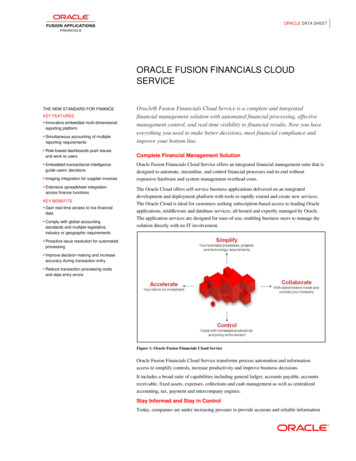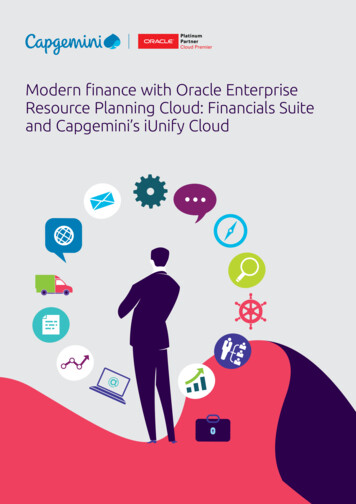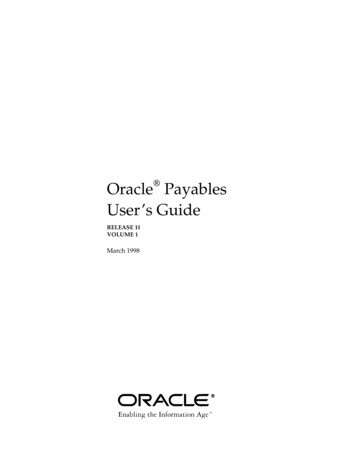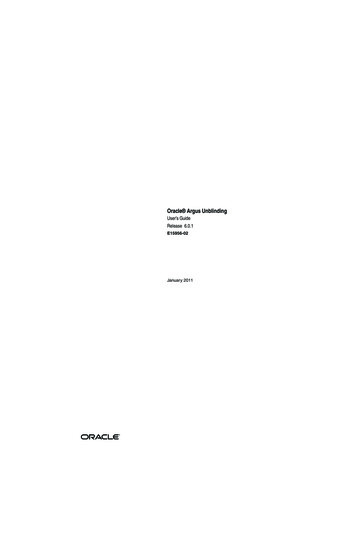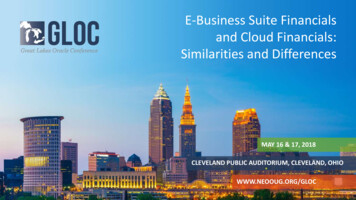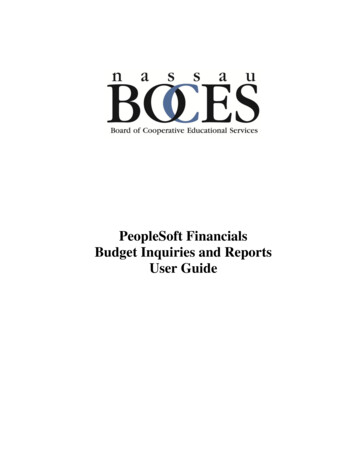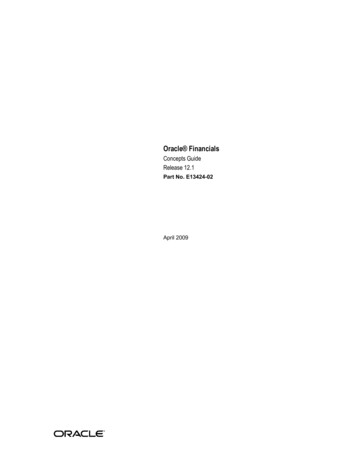
Transcription
Oracle FinancialsConcepts GuideRelease 12.1Part No. E13424-02April 2009
Oracle Financials Concepts Guide, Release 12.1Part No. E13424-02Copyright 2006, 2009, Oracle and/or its affiliates. All rights reserved.Primary Author:Seamus MoranContributing Author: Ayse Aba, Amy Andrews, Ramasubramanian Balasundaram, Jayanta Bhowmik, JohnCafolla, Gail D'Aloisio, Joe Gum, David Haimes, Jacob John, Peggy Larson, Julianna Litwin, Sanjay Mall,Elise Mattei, Annette Melatti, Steven Miranda, Rondy Ng, Omar Tahboub, Harsh Takle, Terrance Wampler,Isaac William, Anne Wong, Linda Wong, Rob ZwiebachOracle is a registered trademark of Oracle Corporation and/or its affiliates. Other names may be trademarksof their respective owners.This software and related documentation are provided under a license agreement containing restrictions onuse and disclosure and are protected by intellectual property laws. Except as expressly permitted in yourlicense agreement or allowed by law, you may not use, copy, reproduce, translate, broadcast, modify, license,transmit, distribute, exhibit, perform, publish or display any part, in any form, or by any means. Reverseengineering, disassembly, or decompilation of this software, unless required by law for interoperability, isprohibited.The information contained herein is subject to change without notice and is not warranted to be error-free. Ifyou find any errors, please report them to us in writing.If this software or related documentation is delivered to the U.S. Government or anyone licensing it on behalfof the U.S. Government, the following notice is applicable:U.S. GOVERNMENT RIGHTSPrograms, software, databases, and related documentation and technical data delivered to U.S. Governmentcustomers are "commercial computer software" or "commercial technical data" pursuant to the applicableFederal Acquisition Regulation and agency-specific supplemental regulations. As such, the use, duplication,disclosure, modification, and adaptation shall be subject to the restrictions and license terms set forth in theapplicable Government contract, and, to the extent applicable by the terms of the Government contract, theadditional rights set forth in FAR 52.227-19, Commercial Computer Software License (December 2007). OracleUSA, Inc., 500 Oracle Parkway, Redwood City, CA 94065.This software is developed for general use in a variety of information management applications. It is notdeveloped or intended for use in any inherently dangerous applications, including applications which maycreate a risk of personal injury. If you use this software in dangerous applications, then you shall beresponsible to take all appropriate fail-safe, backup, redundancy and other measures to ensure the safe use ofthis software. Oracle Corporation and its affiliates disclaim any liability for any damages caused by use of thissoftware in dangerous applications.This software and documentation may provide access to or information on content, products and servicesfrom third parties. Oracle Corporation and its affiliates are not responsible for and expressly disclaim allwarranties of any kind with respect to third party content, products and services. Oracle Corporation and itsaffiliates will not be responsible for any loss, costs, or damages incurred due to your access to or use of thirdparty content, products or services.
ContentsSend Us Your CommentsPreface1IntroductionOverview. 1-1Benefits. 1-2Key Attributes of Oracle E-Business Suite. 1-2Oracle Financials Applications Suite.1-4Using this Guide. 1-52Organizational Models in Oracle FinancialsOverview. 2-1Your Organization. 2-1The Role of Your Legal Entities. 2-4Representing Your Organization in the System. 2-4Organizational Classifications in Oracle Financials. 2-5System Entities. 2-6Chart of Accounts. 2-14A Flexible Model. 2-16Using Oracle Human Resources with Oracle Financials. 2-17Cross Organization Reporting. 2-183ReportingOverview. 3-1Daily Management. 3-1iii
Periodic Management. 3-1Periodic Analysis. 3-2Reports. 3-2Reporting Tools. 3-3Security and Reports. 3-4Reporting and Systems Organizations. 3-44Accounting with Oracle Financials ApplicationsOverview. 4-1Chart of Accounts . 4-2Global Chart of Accounts. 4-2Regulated Charts of Accounts.4-3Currency. 4-4Transaction Currency. 4-5Primary Currency . 4-5Reporting Currency . 4-6Calendars. 4-7Accounting Conventions . 4-7Subledger Accounting in Oracle Financials . 4-8Some Important Features of Oracle Subledger Accounting. 4-10Setting Up Your Accounting: Accounting Setup Manager. 4-12Overview of the Accounting Setup Manager. 4-12Legal Environment Considerations. 4-13The Corporate View. 4-14Accounting Consolidation in Oracle Ledgers .4-15Financial Consolidation Hub . 4-15Ledgers and Ledger Sets with Financial Statement Generator .4-17Global Consolidation System. 4-185Worldwide Operations with Oracle Financials ApplicationsOverview. 5-1Multiple Organizations Support. 5-2Advanced Global Intercompany System . 5-2Facilitating Intercompany Accounting in Oracle Ledgers . 5-3The E-Business Tax Engine. 5-5The Bank Account Model. 5-6Ledgers and Reporting. 5-6Summary. 5-7iv
6Governance, Risk Management, and Compliance with Oracle FinancialsIntroduction. 6-1Regulations and Compliance. 6-2Requirements for Financial Compliance. 6-2An Overview of Oracle's Compliance Architecture. 6-3Enterprise Visibility and Security. 6-5Data and Security Management. 6-5Internal Control & Operational Efficiency. 6-7Automated Processes & Controls in the E-Business Suite.6-7Shared Service Centers. 6-8Standardized Processes. 6-9Oracle Internal Controls Manager. 6-10Oracle Learning Management.6-14Oracle Tutor. 6-14Oracle Collaboration Suite. 6-15Corporate Governance & GAAP. 6-157Business Analytics & Corporate Performance ManagementIntroduction. 7-1The Oracle Business Analytics & Corporate Performance Management Architecture. 7-2Oracle Database 10g. 7-2Oracle Warehouse Builder. 7-3Oracle Business Intelligence. 7-3Oracle Corporate Performance Management Applications. 7-6Overview of the Oracle Corporate Performance Management Suite. 7-6Oracle Balanced Scorecard. 7-9Oracle Enterprise Planning and Budgeting.7-10Oracle Profitability Manager. 7-10Oracle Daily Business Intelligence. 7-12AThe Oracle Financials Product FootprintIntroduction. A-1CRM, Sales, Order Management, Product Management, Procurement, and Supply Chain. A-1Logistics, Maintenance, Human Resources, Service, Finance, and Projects.A-4BIndustry SpecializationsOverview. B-1Enhanced Industry Support. B-1v
Indexvi
Send Us Your CommentsOracle Financials Concepts Guide, Release 12.1Part No. E13424-02Oracle welcomes customers' comments and suggestions on the quality and usefulness of this document.Your feedback is important, and helps us to best meet your needs as a user of our products. For example: Are the implementation steps correct and complete?Did you understand the context of the procedures?Did you find any errors in the information?Does the structure of the information help you with your tasks?Do you need different information or graphics? If so, where, and in what format?Are the examples correct? Do you need more examples?If you find any errors or have any other suggestions for improvement, then please tell us your name, thename of the company who has licensed our products, the title and part number of the documentation andthe chapter, section, and page number (if available).Note: Before sending us your comments, you might like to check that you have the latest version of thedocument and if any concerns are already addressed. To do this, access the new Applications ReleaseOnline Documentation CD available on My Oracle Support and www.oracle.com. It contains the mostcurrent Documentation Library plus all documents revised or released recently.Send your comments to us using the electronic mail address: appsdoc us@oracle.comPlease give your name, address, electronic mail address, and telephone number (optional).If you need assistance with Oracle software, then please contact your support representative or OracleSupport Services.If you require training or instruction in using Oracle software, then please contact your Oracle local officeand inquire about our Oracle University offerings. A list of Oracle offices is available on our Web site atwww.oracle.com.vii
PrefaceIntended AudienceWelcome to Release 12.1 of the Oracle Financials Concepts Guide.This guide assumes you have a working knowledge of the following: The principles and customary practices of your business area. Computer desktop application usage and terminologyIf you have never used Oracle Applications, we suggest you attend one or more of theOracle Applications training classes available through Oracle University.See Related Information Sources on page x for more Oracle Applications productinformation.TTY Relay Access to Oracle Support ServicesTo reach AT&T Customer Assistants, dial 711 or 1.800.855.2880. An AT&T CustomerAssistant will relay information between the customer and Oracle Support Services at1.800.223.1711. Complete instructions for using the AT&T relay services are available html. After the AT&T CustomerAssistant contacts Oracle Support Services, an Oracle Support Services engineer willhandle technical issues and provide customer support according to the Oracle servicerequest process.Documentation AccessibilityOur goal is to make Oracle products, services, and supporting documentation accessibleto all users, including users that are disabled. To that end, our documentation includesfeatures that make information available to users of assistive technology. Thisdocumentation is available in HTML format, and contains markup to facilitate access byix
the disabled community. Accessibility standards will continue to evolve over time, andOracle is actively engaged with other market-leading technology vendors to addresstechnical obstacles so that our documentation can be accessible to all of our customers.For more information, visit the Oracle Accessibility Program Web site ty of Code Examples in DocumentationScreen readers may not always correctly read the code examples in this document. Theconventions for writing code require that closing braces should appear on an otherwiseempty line; however, some screen readers may not always read a line of text thatconsists solely of a bracket or brace.Accessibility of Links to External Web Sites in DocumentationThis documentation may contain links to Web sites of other companies or organizationsthat Oracle does not own or control. Oracle neither evaluates nor makes anyrepresentations regarding the accessibility of these Web sites.Structure1234567ABIntroductionOrganizational Models in Oracle FinancialsReportingAccounting with Oracle Financials ApplicationsWorldwide Operations with Oracle Financials ApplicationsGovernance, Risk Management, and Compliance with Oracle FinancialsBusiness Analytics & Corporate Performance ManagementThe Oracle Financials Product FootprintIndustry SpecializationsRelated Information SourcesThis document is included on the Oracle Applications Document Library, which issupplied in the Release 12 DVD Pack. You can download soft-copy documentation asPDF files from the Oracle Technology Network at http://otn.oracle.com/documentation,or you can purchase hard-copy documentation from the Oracle Store athttp://oraclestore.oracle.com. The Oracle E-Business Suite Documentation LibraryRelease 12 contains the latest information, including any documents that have changedsignificantly between releases. If substantial changes to this book are necessary, arevised version will be made available on the online documentation CD on My OracleSupport.If this guide refers you to other Oracle Applications documentation, use only theRelease 12 versions of those guides.For a full list of documentation resources for Oracle Applications Release 12, see Oraclex
Applications Documentation Resources, Release 12, My Oracle Support Document394692.1.Online DocumentationAll Oracle Applications documentation is available online (HTML or PDF). PDF - PDF documentation is available for download from the Oracle TechnologyNetwork at http://otn.oracle.com/documentation. Online Help - Online help patches (HTML) are available on My Oracle Support. My Oracle Support Knowledge Browser - The My Oracle Support KnowledgeBrowser lets you browse the knowledge base, from a single product page, to find alldocuments for that product area. Use the Knowledge Browser to search forrelease-specific information, such as FAQs, recent patches, alerts, white papers,troubleshooting tips, and other archived documents. Oracle eBusiness Suite Electronic Technical Reference Manuals - Each ElectronicTechnical Reference Manual (eTRM) contains database diagrams and a detaileddescription of database tables, forms, reports, and programs for a specific OracleApplications product. This information helps you convert data from your existingapplications and integrate Oracle Applications data with non-Oracle applications,and write custom reports for Oracle Applications products. Oracle eTRM isavailable on My Oracle Support.Related GuidesYou should have the following related books on hand. Depending on the requirementsof your particular installation, you may also need additional manuals or guides.Oracle Applications Installation Guide: Using Rapid Install:This book is intended for use by anyone who is responsible for installing or upgradingOracle Applications. It provides instructions for running Rapid Install either to carryout a fresh installation of Oracle Applications Release 12, or as part of an upgrade fromRelease 11i to Release 12. The book also describes the steps needed to install thetechnology stack components only, for the special situations where this is applicable.Oracle Applications Upgrade Guide: Release 11i to Release 12:This guide provides information for DBAs and Applications Specialists who areresponsible for upgrading a Release 11i Oracle Applications system (techstack andproducts) to Release 12. In addition to information about applying the upgrade driver,it outlines pre-upgrade steps and post-upgrade steps, and provides descriptions ofproduct-specific functional changes and suggestions for verifying the upgrade andreducing downtime.Oracle Applications Patching Procedures:This guide describes how to patch the Oracle Applications file system and databaseusing AutoPatch, and how to use other patching-related tools like AD Merge Patch,xi
OAM Patch Wizard, and OAM Registered Flagged Files. Describes patch types andstructure, and outlines some of the most commonly used patching procedures. Part ofMaintaining Oracle Applications, a 3-book set that also includes Oracle ApplicationsMaintenance Utilities and Oracle Applications Maintenance Procedures.Oracle Applications Maintenance Utilities:This guide describes how to run utilities, such as AD Administration and ADController, used to maintain the Oracle Applications file system and database. Outlinesthe actions performed by these utilities, such as monitoring parallel processes,generating Applications files, and maintaining Applications database entities. Part ofMaintaining Oracle Applications, a 3-book set that also includes Oracle ApplicationsPatching Procedures and Oracle Applications Maintenance Procedures.Oracle Applications Maintenance Procedures:This guide describes how to use AD maintenance utilities to complete tasks such ascompiling invalid objects, managing parallel processing jobs, and maintaining snapshotinformation. Part of Maintaining Oracle Applications, a 3-book set that also includesOracle Applications Patching Procedures and Oracle Applications MaintenanceUtilities.Oracle Applications Concepts:This book is intended for all those planning to deploy Oracle E-Business Suite Release12, or contemplating significant changes to a configuration. After describing the OracleApplications architecture and technology stack, it focuses on strategic topics, giving abroad outline of the actions needed to achieve a particular goal, plus the installation andconfiguration choices that may be available.Oracle Applications Developer's Guide:This guide contains the coding standards followed by the Oracle Applicationsdevelopment staff. It describes the Oracle Application Object Library componentsneeded to implement the Oracle Applications user interface described in the OracleApplications User Interface Standards for Forms-Based Products. It provides information tohelp you build your custom Oracle Forms Developer forms so that they integrate withOracle Applications. In addition, this guide has information for customizations infeatures such as concurrent programs, flexfields, messages, and logging.Oracle Applications Flexfields Guide:This guide provides flexfields planning, setup, and reference information for the OracleApplications implementation team, as well as for users responsible for the ongoingmaintenance of Oracle Applications product data. This guide also provides informationon creating custom reports on flexfields data.Oracle Applications System Administrator's Guide Documentation Set:This documentation set provides planning and reference information for the OracleApplications System Administrator. Oracle Applications System Administrator's Guide Configuration contains information on system configuration steps, including definingconcurrent programs and managers, enabling Oracle Applications Manager features,xii
and setting up printers and online help. Oracle Applications System Administrator's Guide- Maintenance provides information for frequent tasks such as monitoring your systemwith Oracle Applications Manager, administering Oracle E-Business Suite SecureEnterprise Search, managing concurrent managers and reports, using diagnosticutilities including logging, managing profile options, and using alerts. OracleApplications System Administrator's Guide - Security describes User Management, datasecurity, function security, auditing, and security configurations.Oracle Applications User's Guide:This guide explains how to navigate, enter data, query, and run reports using the userinterface (UI) of Oracle Applications. This guide also includes information on settinguser profiles, as well as running and reviewing concurrent requests.Oracle Applications User Interface Standards for Forms-Based Products:This guide contains the user interface (UI) standards followed by the OracleApplications development staff. It describes the UI for the Oracle Applications productsand how to apply this UI to the design of an application built by using Oracle Forms.Oracle E-Business Suite Diagnostics User's Guide:This manual contains information on implementing, administering, and developingdiagnostics tests in the Oracle E-Business Suite Diagnostics framework.Oracle E-Business Suite Integrated SOA Gateway User's Guide:This guide describes the high level service enablement process, explaining how userscan browse and view the integration interface definitions and services residing inOracle Integration Repository.Oracle E-Business Suite Integrated SOA Gateway Implementation Guide:This guide explains how integration repository administrators can manage andadminister the service enablement process (based on the service-oriented architecture)for both native packaged public integration interfaces and composite services (BPELtype). It also describes how to invoke Web services from Oracle E-Business Suite byemploying the Oracle Workflow Business Event System; how to manage Web servicesecurity; and how to monitor SOAP messages.Oracle E-Business Suite Integrated SOA Gateway Developer's Guide:This guide describes how system integration developers can perform end-to-end serviceintegration activities. These include orchestrating discrete Web services into meaningfulend-to-end business processes using business process execution language (BPEL), anddeploying BPEL processes at run time.It also explains in detail how to invoke Web services using the Service InvocationFramework. This includes defining Web service invocation metadata, invoking Webservices, managing errors, and testing the Web service invocation.Oracle Applications Multiple Organizations Implementation Guide:This guide describes the multiple organizations concepts in Oracle Applications. Itdescribes in detail on setting up and working effectively with multiple organizations inxiii
Oracle Applications.Oracle Advanced Global Intercompany System User's Guide:This guide describes the self service application pages available for Intercompany users.It includes information on setting up intercompany, entering intercompanytransactions, importing transactions from external sources and generating reports.Oracle Advanced Collections User Guide:This guide describes how to use the features of Oracle Advanced Collections to manageyour collections activities. It describes how collections agents and managers can useOracle Advanced Collections to identify delinquent customers, review payment historyand aging data, process payments, use strategies and dunning plans to automate thecollections process, manage work assignments, and handle later-stage delinquencies.Oracle Advanced Collections Implementation Guide:This guide describes how to configure Oracle Advanced Collections and its integratedproducts. It contains the steps required to set up and verify your implementation ofOracle Advanced Collections.Oracle Applications Multiple Organizations Implementation Guide:This guide describes the multiple organizations concepts in Oracle Applications. Itdescribes in detail on setting up and working effectively with multiple organizations inOracle Applications.Oracle Assets User Guide:This guide provides you with information on how to implement and use Oracle Assets.Use this guide to understand the implementation steps required for application use,including defining depreciation books, depreciation method, and asset categories. Italso contains informati
vii Send Us Your Comments Oracle Financials Concepts Guide, Release 12.1 Part No. E13424-02 Oracle welcomes customers' comments and suggestions on the quality and usefulness of this document.


